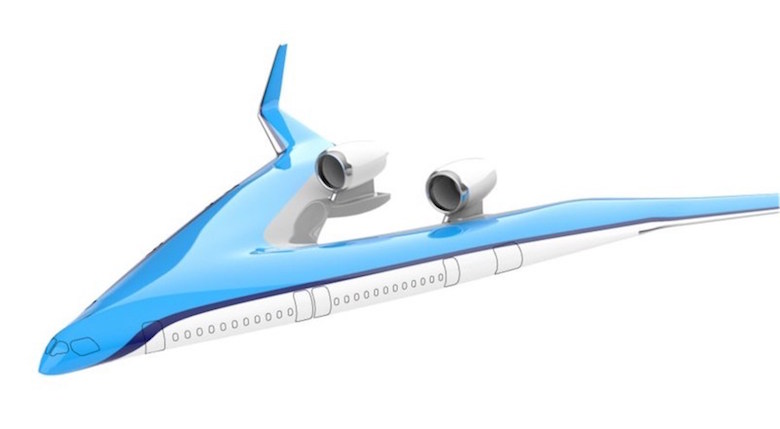The design of the standard passenger airplane seems to be pretty fixed where there is a central fuselage that houses passengers and cargo and the wings that provide the lift. But via David Pescovitz I learn that KLM is funding a new design where the central fuselage is eliminated and passengers and cargo are seated in the wings, as shown below.
KLM claims that the new design has greater energy efficiency.
Intended to improve the sustainability of air travel, the Flying-V was conceived by Justus Benad, then a student at the Technical University of Berlin, and developed by researchers at Delft University of Technology in the Netherlands, also known as TU Delft.
…It’s claimed the plane will use 20% less fuel than the Airbus A350-900 while carrying a similar number of passengers — the Flying-V will seat 314, while the Airbus A350 seats between 300 and 350. The design also mirrors the A350’s 65-meter (213 feet) wingspan, enabling it to use existing airport infrastructure.
…“We’ve been flying these tube and wing airplanes for decades now, but it seems like the configuration is reaching a plateau in terms of energy efficiency,” [TU Delft project leader Roelof Vos] said. “The new configuration that we propose realizes some synergy between the fuselage and the wing. The fuselage actively contributes to the lift of the airplane, and creates less aerodynamic drag.”
There is always a tendency to think that the way things have been for a long time must be the only way that things can be. Fortunately it only takes one or a few people to think differently to get us to view things in a new way.


Wouldn’t want to be a passenger near the back. Engines above, and I suspect the effects of turbulence would be magnified. But this is about profit for airlines, not passenger safety/comfort, right?
Still, it might be progress for cargo transport.
In the article they say they’ve done wind-tunnel testing, but as I look at it, my first two thoughts are 1) how are they generating lift with such fat “wings”? and 2) isn’t there a lot more drag as those passenger compartments face the oncoming air (albeit at a slant)?
When the first operational vehicle has done its testing, it will be known if the actuality matches the expectation. But that’s not now.
Flying wing designs have been proposed before for passenger planes. So far none has gotten even to prototype stage, as far as I know.
I can see some issues with the proposed design. Engine maintenance is more complicated when they’re not mounted below the wings. Jetways and other airport facilities may not be compatible. Flying wings in general have had issues with stability; they have a tendency to oscillate in the yaw axis, producing an uncomfortable experience for the crew (and in this case passengers as well).
I’m not saying it won’t happen, but it’s no slam dunk.
ahcuah @#2,
As I understand it, much of the lift is generated by the so-called angle of attack, the upward slant of the wings, and less by the differential flow of air across the top and bottom of the wings.
Looks like the passengers will be the first to the scene of the accident….
I wouldn’t want to fly it with all the spinning, but if thrown right at least it’ll return to its point of origin.
It won’t happen. Every airport would need new jetways and boarding procedures specific to that plane.
Put six strings and a Fender logo on it and they’ll get a letter from a trademark lawyer.